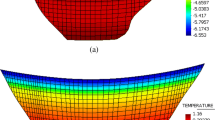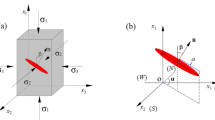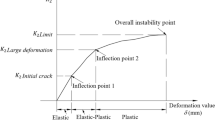Abstract
Unloading relaxation of rock masses in an excavated interface is unfavorable to the performance of the dam foundation system. To evaluate its effects better, a new evaluation method for unloading relaxation is presented in which the unbalanced force beyond the yield surface is proposed as the quantitative criterion of unloading relaxation. It is used for the Baihetan arch dam to analyze the unloading relaxation characteristics and its effects on the displacement, stress, fracture and global stability of the dam. The results show that the unbalanced force is mainly located on the surface of the slope where faults are exposed, which agrees well with the observations. Unloading relaxation has a limited impact on the displacement, stress, fracture and global stability of the dam and LS331 should be paid more attention. The optimization of dam shape is also discussed, the result of which is that it is better to have a smooth dam shape and the slope of the scarp should be lowered.
















Similar content being viewed by others
Abbreviations
- \(\Delta {\varvec{U}}\) :
-
Unbalanced force
- \(\Delta E\) :
-
Plastic complementary energy
- \({\varvec{B}}\) :
-
Displacement gradient matrix
- \({\varvec{C}}\) :
-
Elastic compliance tensor
- \({\varvec{\sigma}^{eq}}\) :
-
Elastic stress field
- \({\varvec{\sigma}^{{\text{yc}}}}\) :
-
Final stress field
- \(\dot {\varvec{\varepsilon}}\) :
-
Total strain rate
- \({\dot {\varvec{\varepsilon}}^{\text{e}}}\) :
-
Elastic strain rate
- \({\dot {\varvec{\varepsilon}}^{{\text{vp}}}}\) :
-
Viscoplastic strain rate
- \(\dot {\varvec{\sigma}}\) :
-
Stress rate
- \(\varvec{\sigma}\) :
-
Normal stress
- \(\overline {\varvec{\sigma}}\) :
-
Average stress
- \(\mu\) :
-
Viscous coefficient
- \(\alpha ,{\text{ }}k\) :
-
Strength parameters for the Drucker–Prager criterion
- \({I_1}\) :
-
First invariant of total stress
- \({J_2}\) :
-
Second invariant of deviator stress
- \({\varvec{F}}\) :
-
Nodal force vector
References
Al-rub RKA, Voyiadjis GZ (2009) Gradient-enhanced coupled plasticity-anisotropic damage model for concrete fracture: computational aspects and applications. Int J Damage Mech 18(2):115–154
An L, Jin CY, Liu D, Ding CG, Dai XH (2018) Mechanism of core discing in the relaxation zone around and underground opening under high in situ stress. Bull Eng Geol Environ 77(3):1179–1189
Dai F, Li B, Xu N, Fan Y, Zhang C (2016) Deformation forecasting and stability analysis of large-scale underground powerhouse caverns from microseismic monitoring. Int J Rock Mech Min Sci 86:269–281
Duvant G, Lions JL (1976) Inequalities in mechanics and physics. Springer-Verlag, Berlin
Fakhimi AA, Fairhurst C (1994) A model for the time-dependent behavior of rock. Int J Rock Mech Min Sci Geomech Abstr 31(2):117–126
Fan QX, Feng XT, Weng WL, Fan YL, Jiang Q (2017) Unloading performances and stabilizing practices for columnar jointed basalt: a case study of Baihetan hydropower station. J Rock Mech Geotech Eng 9(6):1041–1053
Fan QX, Wang ZL, Xu JR, Zhou MX, Jiang Q, Li G (2018) Study on deformation and control measures of columnar jointed basalt for Baihetan super-high arch dam foundation. Rock Mech Rock Eng 51:2569–2595
Feng XM, Chen SH, Li WG (2009) Research on unloading relaxation criterion of high rocky slope excavation and its engingeering application. Rock Soil Mech 30(S2):452–456 (in Chinese)
Ha QL (1997) Rock slope engineering and unloading nonlinear rock mass mechanics. Chin J Rock Mech Eng 16(4):386–391 (in Chinese)
Han G, Zhao QH, Peng SQ (2011) In-situ stress field evolution of deep fracture rock mass at dam area of Baihetan hydropower station. Rock Soli Mech 32(1):583–589 (in Chinese)
Hirata A, Kameoka Y, Hirano T (2007) Safety management based on detection of possible rock bursts by AE monitoring during tunnel excavation. Rock Mech Rock Eng 40(6):563–576
Huang RQ, Lin F, Chen DJ, Wang JH (2001) Formation mechanism of unloading fracture zone of high slopes and its engineering behaviors. J Eng Geol 9(3):227–232 (in Chinese)
Jiang Q, Feng XT, Hatzor YH, Hao XJ, Li SJ (2014) Mechanical anisotropy of columnar jointed basalts: an example from the Baihetan hydropower station, China. Eng Geol 175(3):35–45
Jin CY, Yang CX, Fang D, Xu S (2015) Study on the failure mechanism of basalts with columnar joints in the unloading process on the basis of an experimental cavity. Rock Mech Rock Eng 48(3):1275–1288
Li WS, Zhou HM, Chen H, Liu Y, Ling W (2010) Study of unloading rock mass deformation parameters for high arch dam foundation base of Goupitan Hydropower Station. Chin J Rock Mech Eng 29(7):1333–1338 (in Chinese)
Li HB, Liu MC, Xing WB, Shao S, Zhou JW (2017) Failure mechanisms and evolution assessment of the excavation damaged zones in a large-scale and deeply buried underground powerhouse. Rock Mech Rock Eng 50(7):1883–1900
Lin P, Wang RK, Zhou YN, Zhou WY (2008) Study of shallow unloading mechanism and stability of foundation interface of super high arch dam. Rock Soil Mech 29(S):8–14 (in Chinese)
Liu YR, Chang Q, Yang Q, Wang CQ, Guan FH (2011) Fracture analysis of rock mass based on 3-D nonlinear Finite Element Method. Sci China Tech Sci 54(3):556–564
Liu YR, Wang CQ, Yang Q (2012) Stability analysis of soil slope based on deformation reinforcement theory. Finite Elem Anal Des 58(8):10–19
Liu YR, He Z, Yang Q, Deng JQ, Xue LJ (2016) Long-term stability analysis for high arch dam based on time-dependent deformation reinforcement theory. Int J Geomech 17(4):04016092
Londe P (1987) The Malpasset dam failure. Eng Geol 24(1–4):331–338
Matsuki K, Nakama S, Sato T (2009) Estimation of regional stress by FEM for a heterogeneous rock mass with a large fault. Int J Rock Mech Min Sci 46(1):31–50
Pan JZ, Chen SH (1997) Some problems on the construction of high arch dams. Sci Technol Rev 15(2):17–19 (in Chinese)
Pan YW, Liu YR, Cui ZX, Chen X, Yang Q (2013) Fracture analysis of brittle materials based on nonlinear FEM and application in arch dam with fractures. J Appl Math 2013:1–12
Perzyna P (1966) Fundamental problems in viscoplasticity. Adv Appl Mech 9:243–377
Ru NH, Jiang ZS (1995) Arch dams, incidents and safety of large dams. China Water Power Press, Beijing (in Chinese)
Seanson SR, Brown WS (1971) An observation of loading path independence of fracture in rock. Int J Rock Mech Min Sci Geomech Abs 8(3):277–281
Shen XM, Niu XQ, Lu WB, Chen M, Yan P, Wang GH, Leng ZD (2017) Rock mass utilization for the foundation surfaces of high arch dams in medium or high geo-stress regions: a review. Bull Eng Geol Environ 76(2):795–813
Simo JC, Hughes T (2008) Computational inelasticity. Springer-Verlag, Berlin
Simo JC, Kennedy JG, Govindjee S (1998) Non-smooth multisurface viscoplasticity: loading unloading conditions and numerical algorithms. Int J Numer Methods Eng 26:2161–2185
Su SR (2004) Effect of fractures on in-situ stresses studied by the distinct element method. Int J Rock Mech Min Sci 41(1):159–164
Su SR, Stephansson O (1999) Effect of a fault on in-situ stress studied by distinct element method. Int J Rock Mech Min Sci 36(8):1051–1056
Sun LJ, Zhu YQ, Yang GL, Yin JY (2009) Numerical simulation of ground stress field at ends and vicinity of a fault. J Geodesy Geodyn 29(2):7–12
Tan WH, Kulatilake PHSW, Sun HB, Sun ZH (2014) Effect of faults on in situ stress state in an open-pit mine. Electron J Geotech Eng 19:9597–9629
Wu FQ, Liu T, Liu JY, Tang XL (2009) Excavation unloading destruction phenomena in rock dam foundations. Bull Eng Geol Environ 68(2):257–262
Yang Q, Liu YR, Zhou WY (2008) Deformation reinforcement theory and its application to high arch dams. Sci China Technol Sci 51(S2):32–47
Yang BQ, Zhang L, Hu CQ, Chen JY (2011) Study of shallow unloading effects and stability of high arch dams with complex batholith. J Sichuan Univ (Eng Sci) 43(5):71–76 (in Chinese)
Yang Q, Leng KD, Chang Q, Liu YR (2013) Failure mechanism and control of geotechnical structures. Constitutive modeling of geomaterials. Springer, New York, pp 63–87
Yang HQ, Liu JF, Zhou XP (2017a) Effects of the loading and unloading conditions on the stress relaxation behavior of pre-cracked granite. Rock Mech Rock Eng 50(5):1157–1169
Yang Q, Liu YR, Cheng L (2017b) New understandings on the stability of high arch dam//Zhang CH. In: Wang GQ Water conservancy science and engineering fronts. Science Press, Beijing
Zhang L, Liu YR, Yang Q (2014) Evaluation of reinforcement and analysis of stability of a high arch dam based on geomechanical model testing. Rock Mech Rock Eng 48(2):803–818
Zhao XG, Wang J, Cai M, Cheng C, Ma LK, Su R, Zhao F, Li DJ (2014) Influence of unloading rate on the strainburst characteristics of Beishan granite under ture-triaxial unloading conditions. Rock Mech Rock Eng 47(2):467–483
Zhou H, Wang WM, Chen SH (2009) Relaxation criterion and finite element analysis of rock mass excavation. J Huazhong Univ of Sci Technol Nat Sci 37(6):112–116 (in Chinese)
Zhuang DY, Tang CA, Liang ZZ, Ma K, Wang SY, Liang JZ (2017) Effects of excavation unloading on the energy-release patterns and stability of underground water-sealed oil storage caverns. Tunn Undergr Space Technol 61:122–133
Zienkiewicz OC, Cormeau IC (1974) Visco-plasticity-plasticity and creep in elastic solids—a unified numerical solution approach. Int J Numer Methods Eng 8(4):821–845
Acknowledgements
The work reported here was supported by the National Science Foundation of China with Grant nos. 51479097 and 51739006, as well as the State Key Laboratory of Hydroscience and Engineering of Hydroscience with Grant no. 2016-KY-2.
Author information
Authors and Affiliations
Corresponding author
Additional information
Publisher’s Note
Springer Nature remains neutral with regard to jurisdictional claims in published maps and institutional affiliations.
Rights and permissions
About this article
Cite this article
Zhong, D., Liu, Y., Cheng, L. et al. Study of Unloading Relaxation for Excavation Based on Unbalanced Force and Its Application in Baihetan Arch Dam. Rock Mech Rock Eng 52, 1819–1833 (2019). https://doi.org/10.1007/s00603-018-1653-4
Received:
Accepted:
Published:
Issue Date:
DOI: https://doi.org/10.1007/s00603-018-1653-4




